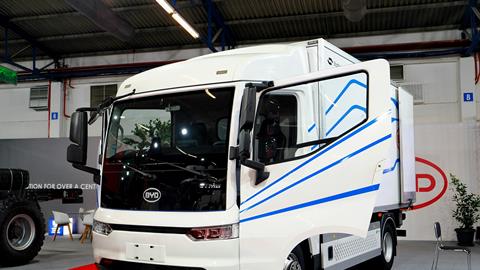While the UK is the second highest European market for sales of electric medium and heavy duty commercial vehicles, with over 600 sold in the first half of 2024, this pales in comparison to China, which takes the lion’s share of global sales, new research reveals.
According to the latest Bloomberg NEF report: Zero-Emission Commercial Vehicles: The Time Is Now, sales of medium and heavy trucks with zero tailpipe emissions are growing fast, but the market is still in the early stages.
In Europe, sales are concentrated in a handful of countries, with Germany in first place with approximately 1,900 sales and the UK coming second with over 600 sales, of which around half are large medium duty vans. Meanwhile the US market shows only limited market growth, the report revealed.
In comparison, sales in China account for more than 80% of a global volume of almost 38,000 units, with adoption in China approaching 5.5% in the first half of 2024
The report found that adoption varies widely between countries and vehicle use cases, though economics are steadily improving as battery prices fall and there is a growing opportunity for creative financing and business models to help this market scale up, the research revealed.
Battery-electric trucks accounted for more than 90% of zero-emission medium and heavy truck sales in the first half of 2024.
Fuel-cell trucks have mostly been sold in China, where subsidies and availability of hydrogen fuel as a by-product from industrial operations have supported the market. Battery swapping is also playing a role.
The report said China benefits from the availability of low cost batteries for commercial vehicle, coming in at $100 (£75) per kilowatt-hour. However the report notes that prices elsewhere have been declining faster. BNEF expects battery packs for trucks to cost as little as $88/kWh (£66/kWh) by 2030.
The report also found that electric trucks are quickly becoming economically competitive with equivalent diesel vehicles, starting with shorter routes.
It predicts that heavy-duty long-haul battery trucks are capable of reaching total cost of ownership parity, even before 2030, adding that fuel-cell truck costs may also drop by that time, but the decline trajectory is far less certain.
In addition, while progress varies and remains limited for some large truckmakers, strict emissions standards in Europe and the US should kickstart stronger growth.
However the report warns that while zero-emission vehicle economics improve, capital cost and refuelling challenges remain. On the upside, new business models and financing structures are emerging to tackle such hurdles, the report adds.
These include partnerships between fleet owners and operators to co-develop refueling stations, raising financing supported by fleet utilization agreements, and extending the revenue potential of vehicle batteries by reusing them in stationary energy storage applications.
“Fleet owners and investors that grab the early opportunities help create the necessary scale for themselves and the market to sustain further growth,” the report concludes.

















